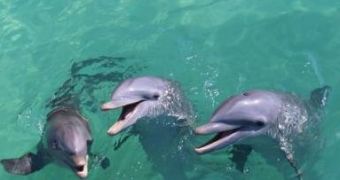We, humans, live in a visual world. 90 % of our information concerning the environment comes through our eyes. But if we refer to cetaceans (dolphins and whales), their world is mainly auditive.
These animals practically "see" with their ears, employing the ultrasound ecolocation, as vision in the water is greatly impaired by its turbidity and depth (light does not go deeper than 200 m (660 ft)).
Moreover, a dolphin brain area linked to auditive processing is as greatly enlarged as the human ones connected to visual processing. This has also much to do with the dolphins' sound communication. You almost never see a quiet dolphin. Dolphins make an array of sounds, including different types of clicks and species-specific whistles, some in the audible range, others are ultrasounds (over 20 kHz), not heard by the human hear. Most whistles are made up of frequencies between 2 and 30 kilohertz, with each species combining the frequencies in a specific way.
A new software can now identify various dolphin species by their whistles and could improve the data gathered by surveys monitoring possible harm from fishing fleets. Current surveys are made by observing the animals from a boat. But a decrease in the number of sightings of particular species are a warning that signals that it's time to check what the fishermen are up to. "But visual surveys pose problems. Marine mammals spend most of their time out of sight and underwater, so observer teams can miss a lot of the animals. To make matters worse, some species are shy of boats", she Julie Oswald of the Scripps Institution of Oceanography in San Diego, California.
Some cetacean species, like beaked whales (a type of large dolphins) are so shy that species have been described only based on observations from distance. These deep ocean creatures are one of the least-known families of large mammals: several species have only been described in the last two decades and it is entirely possible that more remain as yet undiscovered. Thus, the classical method is highly ineffective for the identification of the species, for instance.
Now, Oswald's team has turned to acoustics to track down hidden dolphins and easily determine their species. The scientists trail underwater microphones from a survey boat and process the sound they pick up on an on-board computer. The software then compares the sounds' frequencies captured by the microphones with models from the database and determines the species that have emitted it.
In field trials, the software determined up to eight species of cetaceans near a research boat with up to 80 % accuracy.

 14 DAY TRIAL //
14 DAY TRIAL //